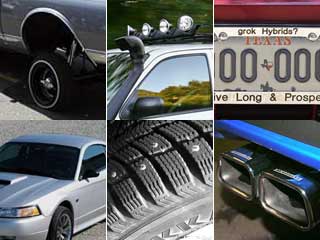
Are
you street legal?
State
and local rules
can very greatly.

From
an article by AOL Autos
Not
only might an accessorized look that hits the mark in San Diego not
play in Peoria, it might not be legal there. And take an off-road
lifted, window-tinted, modified truck to quaint, coastal New England,
and you might just get a ticket.
Local and state rules for accessories and vehicle modification vary
greatly. States can’t issue regulations that conflict with federal
standards (FMVSS), which set performance requirements, not design
requirements for vehicles; but states are free to establish their
own regulations and rules where ones from the federal government don’t
already exist. And they certainly have.
Beyond obvious upkeep issues like rust, leaky exhausts, and headlights
that don’t work, here are ten rather unexpected reasons why,
within the U.S. your vehicle might be street-legal in one place and
illegal in another.
 Window
Tinting
Window
Tinting
This one’s frustrating. Almost every state law has its own rules
on window tinting -- especially light transmittance, usually given
as a percentage -- and they’re all over the place. Regulations
typically range from 50 or 70 percent for the driver’s side
in much of the upper Midwest and East Coast (a very light tint) to
less than 30 percent in many Southern states. To complicate matters
more, some states place more of a restriction on the driver’s
side window. Get a lighter tint in the first place, and you’re
much less likely to run into trouble when you move and re-register.
 Aftermarket
Exhaust
Aftermarket
Exhaust
Your vehicle upgrade could be as simple as a new exhaust pipe or muffler,
a resonator, or even an exhaust tip that’s mostly decorative,
yet if the new setup is noticeably louder than the stock system you
might be bait for a citation -- depending greatly on where you are.
According to Steve McDonald, vice president for government affairs
for the Specialty Equipment Market Association (SEMA), Massachusetts
is among the most restrictive states in this respect, as the state
has a law on the books that prohibits the use of exhaust-system components
that increase sound output, and every year a law is introduced (and
fortunately killed) that would prohibit the installation of any aftermarket
exhaust components.
Even where the state restrictions aren’t as tight and you’ve
installed an exhaust that’s fully legal, you can still get cited
for an aftermarket exhaust. It’s really dependent on enforcement
and at the officer’s discretion, said McDonald, who noted that
some states rely on officers to judge whether an exhaust is significantly
louder than stock (which means that they’re supposed to know
how loud a particular model usually is). Others, like California,
now rely on a test-station system where decibels are objectively measured.
As if that’s not enough, even if you’re legal on the state
level, some communities might essentially have rules stating that
if there are multiple noise complaints, an owner or vehicle will be
cited.
 Aftermarket
Catalytic Converter
Aftermarket
Catalytic Converter
Under the tighter new emissions-check system employed by the state
of California, if you’ve recently replaced your catalytic converter
-- especially in another state -- with one that’s not official
original equipment (OE), you might not be legal in the Golden State.
Check CARB’s Web site to make sure that you are. If you have
an aftermarket catalytic converter that was installed before January
1, 2009 and is otherwise functioning, you should be okay.
 Cold
Air Intake
Cold
Air Intake
It’s a common and inexpensive modification, especially on four-cylinder
import cars and muscle cars; cold-air intakes reach farther away from
the engine, even above the hood, for colder intake air and allow the
engine in some cases to produce more power. The unfortunate result
of a cold-air intake, often, is increased fuel consumption and increased
emissions, so even if you think the engine is running better you might
be illegal and exceed emissions limits. California’s Air Resource
Board (CARB) keeps a database of intakes, among other parts, that
don’t appreciably alter emissions, and a number of other states,
including Oregon, are beginning to follow CARB’s list. Make
sure yours is on the list or you might not pass your next inspection.
 HID
Headlamp Kits
HID
Headlamp Kits
You might be able to get a very functional, reliable, and sophisticated
aftermarket installation of modern high-intensity discharge (HID)
headlamps, but no matter how perfect, they’re not legal -- anywhere
in the U.S. Even if you can adjust your added-on HID lamps to federal
photometric standards, the National Highway Traffic Safety Administration
(NHTSA) has determined that no HID headlamp can comply with the federal
standard. Be forewarned, if you have a model that doesn’t typically
have HID headlamps, you’ll get a ticket in most states.
 Undercarriage
Lighting
Undercarriage
Lighting
Adding a few blue lights underneath your car to add a nighttime ‘aura’
might seem a harmless modification -- but you could quite easily end
up with a setup that advertises itself, brightly, as street-illegal.
According to SEMA’s McDonald, states still aren’t in agreement
on which types of lighting -- neon or LED -- or even which colors,
to allow. Technically any lighting that doesn’t interfere with
the front and rear lighting required by the federal government is
legal, but states have gone further by restricting certain colors
and combinations that could be distracting, or misunderstood with
traffic lights or emergency vehicles. Blue might be perfectly legal
in one state and not another.
 Off-Road
Lamps
Off-Road
Lamps
These powerful lights, often 100 watts or more each, are sometimes
mounted in a bar on the roof or around the grille of a vehicle. Because
of their high intensity, diffused light pattern, and long range, these
beams can be dangerous to oncoming road traffic. You might have known
that, but you might not have realized that in some states, if you
don’t keep off-road lamps physically covered when you’re
not off-roading, they’re technically illegal. Yes, even when
they’re turned off.
 Studded
Tires
Studded
Tires
Studded tires carry the federal government’s DOT rating and
are great for getting a better grip on slippery winter roads -- especially
where steep hills and ice render all-season tires and some standard
winter treads inadequate. And for most modern studded tires, the metal
studs embedded in the tread are much quieter than previous designs.
But they also wreak havoc on pavement surfaces. “There are states
that allow studded tires, and those that don’t,” summed
Matt Edmonds, vice president of the Tire Rack, most of them in the
Rocky Mountain region and West. “But even those that do have
a specific time period.”
 License
Plate Frames
License
Plate Frames
The plastic or metal frames that hold your license plate in place,
keep it from rattling, and possibly advertise your dealership might
be illegal in some states. Arizona just last year introduced new requirements
-- partly because of the number of state-issued custom and vanity
plates -- that specified that “Arizona” must be showing,
not covered up by a top section of the frame. As for those tinted
or reflective license-plate covers: they’re illegal in most
states.
 Too Much Lift
Too Much Lift
Most
states (Wyoming is one exception we could find) place a limit on how
high you can raise a vehicle -- whether it be through frame-and-body
alterations or suspension modifications. Again here, it’s very
confusing; some states have maximum headlight and taillight heights
to meet, while others go by maximum bumper heights instead. For example,
Rhode Island restricts light-vehicle truck or car owners from raising
their vehicle more than four inches -- making the hardcore off-road
look for trucks virtually impossible -- while Wyoming has no measurable
limit. If you’re moving state to state in the wrong direction,
your truck (or car) could quickly be illegal. This is one where you
should consult your state’s DMV or DOT Web site.
Oddly, there are no federal regulations, and few state rules, that
control what size wheels and tires you can put on a vehicle. Whether
it be a low-riding off-road vehicle running dubs, or a sedan that’s
been raised several feet with huge, skinny wheels, it’s your
prerogative. “There really are no regulations ... unfortunately,”
lamented Tire Rack’s Edmonds, pointing only to lift restrictions.
With respect to outrageous tires and wheels, it’s up to the
owner to make sure that they’re fully compatible and it meets
the load-carrying capacity for the vehicle. It’s a question
that you’ll need to address with an expert when upgrading, but
it’s nothing that you might be cited for.
Well...perhaps by the style police." --

The
citation...No helmet!
Some
cops just have no sense of humor!
"I
had a flat tire yesterday; so, I pulled over, got out of the car and
opened my trunk.
I took out my cardboard men, unfolded them and stood them at the rear
of my car facing oncoming traffic. They look so life-like you wouldn't
believe it!
Just as I had hoped, cars started slowing down looking at the men
which made it much safer for me to work on the side of the road!
People honked and waved, and it wasn't long before a state police
cruiser pulled up behind me.
He wanted to know what the heck I was doing so I calmly explained
that I was changing my flat. He told me he could see that, but demanded
to know what the heck my cardboard men were doing standing at the
rear of my car.
I couldn't believe he didn't know ... SO I told him.
"Well, DUH! They're my Emergency Flashers!"

NowYouKnowThatYouKnow.com




Back To Beginning

More Web sites by
KhalsaWebMasters.com

 ®
®
Khalsa
WebMasters.com
© All rights reserved.
